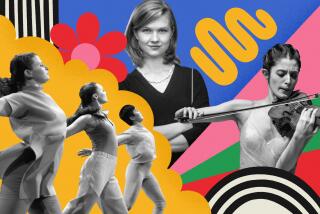If You Paid Full Price . . .
- Share via
This week’s column is intended to reinforce the notion that paying full price for classical CDs, except when a specific artist is required or there’s no choice, is lunacy. By going the whole financial hog, i.e., roughly $15 a disc, you stand a better-than-even chance of getting artists who couldn’t hope to fill a concert hall and who cost what they do for reasons that have more to do with greedy management and contractual esoterica than with artistic accomplishment.
When the long-playing record was introduced, circa 1950, premium prices were charged for reissues by the major artists of a previous generation. Today, historical recordings are the cheapos. And history has a way of becoming compressed too. During the LP’s infancy, a “classic” came from the 1920s or ‘30s. Today, the passing of only a decade can confirm near-legendary status. And that means lower prices.
With the advent of the Naxos label, we’re also finding an increasing number of brand-new quality recordings at low prices, often employing first-rate artists who for one reason or another don’t command top fees and are recorded away from the pricier American and European venues.
Among the reissues, take the case of Hungarian pianist Annie Fischer, who died a few months ago at the age of 80. Fischer, a highly regarded artist with a smallish, connoisseur audience, last appeared locally at Ambassador Auditorium in 1988. She was a self-critical, studio-shy performer whose handful of recordings had all but vanished until the recent appearance on EMI’s super-budget Seraphim label (68529, two CDs) of four of Mozart’s greatest concertos, all of which originally appeared in 1960.
In the familiar No. 21 in C, K. 467, and the no less magnificent No. 22 in E flat, K. 482, Fischer showed a remarkable ability to project a specific Mozart style before most of her colleagues were aware that his music had special interpretive requirements.
Fischer gave us the singing line but with rhythmic backbone and without the Romantic distortions or prettifying miniaturization that variously afflicted the Mozart playing of so many of her contemporaries.
In both K. 467 and K. 482, Fischer works hand in glove with Wolfgang Sawallisch and London’s Philharmonia Orchestra, then in its early prime. It’s hard to believe that this sensitive, attentive conductor is the same pedant who presides over the Philadelphia Orchestra today.
If Fischer was the catalyst for Sawallisch’s relaxed, humane conducting, she wasn’t able to work comparable wonders with her sober-sided partner, Sir Adrian Boult, in the other two great concertos here, No. 20 in D minor, K. 466, and No. 23 in A, K. 488.
Still, she scores her share of winning points in both, and the pianist and conductor are in perfect, magical accord in the ineffable slow movement of K. 488.
From Hungary as well comes the ubiquitous pianist Jeno Jando, whose latest foray into Bartok is only the third or fourth recording of that composer’s 1904 Piano Quintet. Jando is joined by the excellent Kodaly Quartet of Budapest (Naxos 550886).
The quintet was written before Bartok had found his personal style--jagged, percussive, folk-based. It came in the wake of his first exposure to Richard Strauss’ “Also sprach Zarathustra,” and it reeks of the German composer’s emotional excesses in general, while suggesting Brahms here and there and in its slow movement paying homage to Franck’s mystical meanderings.
Then, in the finale, for the first time in Bartok’s output, the nationalistic element breaks out, with some peppery czardas rhythms.
It’s a big, blowzy piece, hardly a model of organization or thematic development and improbably long at nearly 45 minutes. But it’s also full of a yearning, of youthfully overreaching spirit, of trying to say everything as passionately as possible. It’s hard to resist, particularly as played by these superbly skilled and dedicated artists.
Naxos’ generous all-Bartok program includes another, even earlier Straussian rarity--a brief Adagio movement for violin and piano--and the two later, familiar Rhapsodies, with the excellent violinist Gyorgy Pauk partnering Jando in all three.
More to Read
The biggest entertainment stories
Get our big stories about Hollywood, film, television, music, arts, culture and more right in your inbox as soon as they publish.
You may occasionally receive promotional content from the Los Angeles Times.










